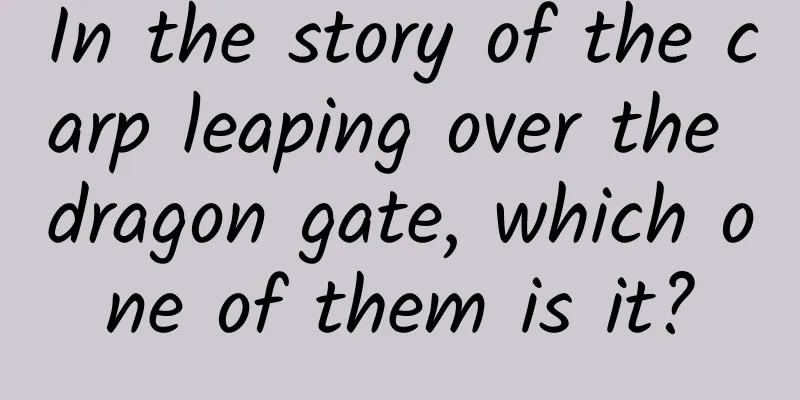In the story of the carp leaping over the dragon gate, which one of them is it?

|
We often hear various legends about carp leaping over the Dragon Gate, but do carp really leap over the Dragon Gate in reality? The answer is yes, but the Dragon Gate in reality is a little different from the magnificent Dragon Gate we imagine. In Longmen Town, Nanchong City, Sichuan Province, there is a Longmen Gorge, which is the legendary "Dragon Gate". The gate at the entrance of Nanchong Garden of Chongqing Garden Expo Park symbolizes this "Dragon Gate". According to the "Longmen Town Chronicles", Longmen Town was originally called Anfuchang. In the Tang Dynasty, the Jialing River changed its course and cut off the mountain to the north of Anfuchang, forming the Longmen Gorge, and Longmen Town got its name from this. At the bottom of the Longmen Gorge, there is a huge stone across the gorge, like a huge threshold. Every summer and autumn, when the river rises, groups of carp will follow the surging water and leap from bottom to top, competing to cross this huge "threshold", which is very dangerous. Later, the vast scene of carp leaping over the Dragon Gate gradually evolved into various versions of myths and legends. According to the legend, the carp that crosses this threshold will transform into a dragon robe, and from then on become a dragon, soaring straight up to the blue sky. In reality, people often use "carp leaping over the Dragon Gate" to symbolize passing the imperial examination or working hard to achieve success. In fact, in addition to Longmen Town in Nanchong City, Sichuan Province, the legend of "Carp Leaping Over the Dragon Gate" is also circulating in Longmen Grottoes in Luoyang, Henan Province and Yumenkou in Hejin City, Shanxi Province. So which of these places is the "Dragon Gate" in "Carp Leaping Over Dragon Gate"? The answer to this question has not yet been determined. In the "Taiping Guangji" quoting the lost "Sanqinji", it was mentioned: "Longmen Mountain is in the Hedong boundary... Every spring, yellow carp from the sea and rivers rush to it. When they first climb the Dragon Gate, clouds and rain follow, and heavenly fire burns their tails from behind, and they turn into dragons." The Hedong boundary refers to the land east of the Yellow River. The "Dragon Gate" here is the Yumenkou in Hejin, Shanxi, which we just mentioned. In addition, Tang Dynasty poet Li Bai also wrote in his poem "Presented to Cui Shiyu": "The three-foot-long carp in the Yellow River originally lived in Mengjin. They could not become dragons after scratching their foreheads, so they returned to live with ordinary fish." The "Mengjin" mentioned in the poem is the name of an ancient ferry crossing on the Yellow River. The meaning of the poem is: the carp originally living in Mengjin swam upstream and swam to the Longmen in Yique (the location of the Longmen Grottoes today). Those who jumped over the Longmen became dragons, while those who could not jumped over it left a black scar on their foreheads and returned to the river to continue their previous lives. This poem by the poet Li Bai confirms that "Longmen" refers to the "Longmen" in Luoyang. In fact, regardless of whether there are differences in ancient books, the idea conveyed by the legend of carp leaping over the Dragon Gate handed down by our Chinese nation is the same, that is: the little carps determined the goal of leaping over the Dragon Gate, and they were not afraid of difficulties and dangers, and they moved forward indomitable and courageous. This spirit is worth learning for all of us. Let us inherit and carry forward this spirit, not afraid of difficulties and dangers, and move forward bravely! Source: Chongqing Garden Expo Park Management Office Audit expert: Li Yuanyuan Statement: Except for original content and special notes, some pictures are from the Internet. They are not for commercial purposes and are only used as popular science materials. The copyright belongs to the original authors. If there is any infringement, please contact us to delete them. |
<<: The "magic drug" that changed the world! Was aspirin born from a doctor's filial piety?
Recommend
The efficacy and function of Smilax china
Smilax glabra is a kind of traditional Chinese me...
Side effects of Smilax glabra
Smilax glabra is a shrub that grows mostly on hil...
Laji Mountain: The unique romance of summer on the plateau
Laji Mountain Located in the eastern section of t...
Chinese medicine prescription for high prolactin
For many people, this may be the first time they ...
What are the Chinese medicine formulas for external application of synovitis?
As a common inflammatory disease, synovitis is ac...
Can you buy your privacy for 300 yuan?! How terrible is "opening the box"...
Is your privacy still safe? Do you dare to believ...
The efficacy and function of tangerine peel
Friends who don’t know tangerine peel will not un...
The efficacy and function of neem leaves
Do you know what neem leaves are? If you know, do...
What is the "Sky Eye" looking at? Could it have received alien signals?
Guizhou Sky Eye is the nickname of the 500-meter ...
The most weight-loss-enhancing fruit in autumn, I won’t let you not know!
Autumn is here. There is a kind of fruit with gol...
The efficacy and function of bitter sky eggplant leaves
Traditional Chinese medicine is very helpful in t...
Do Polygonum multiflorum products have side effects?
Polygonum multiflorum is a common Chinese medicin...
What are the medicinal values of cotton root?
Friends who have been to the countryside must be ...
The efficacy and function of canna
What are the functions of canna? As a traditional...
The efficacy and function of licorice tablets
Medicine is the best choice for treating diseases...









